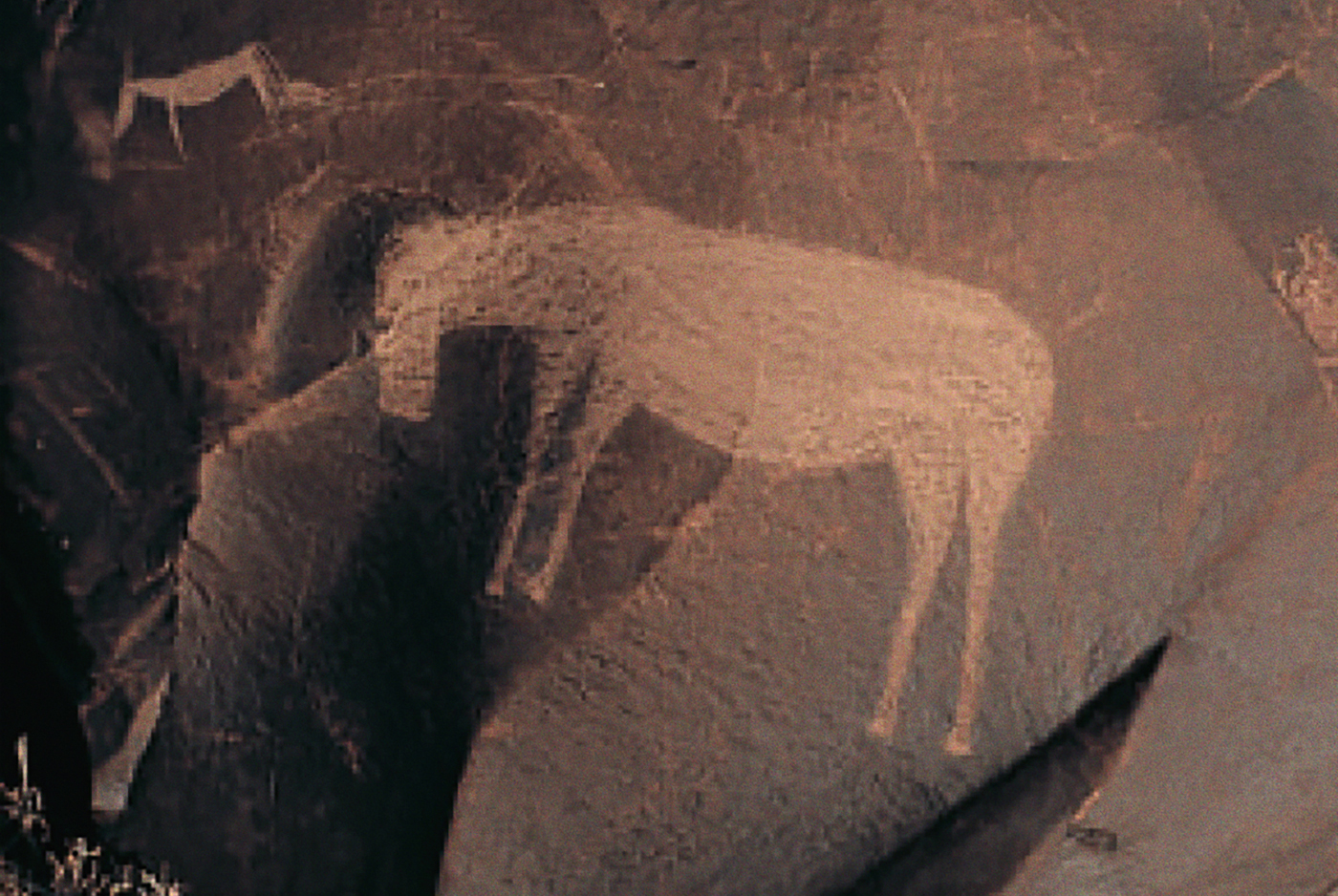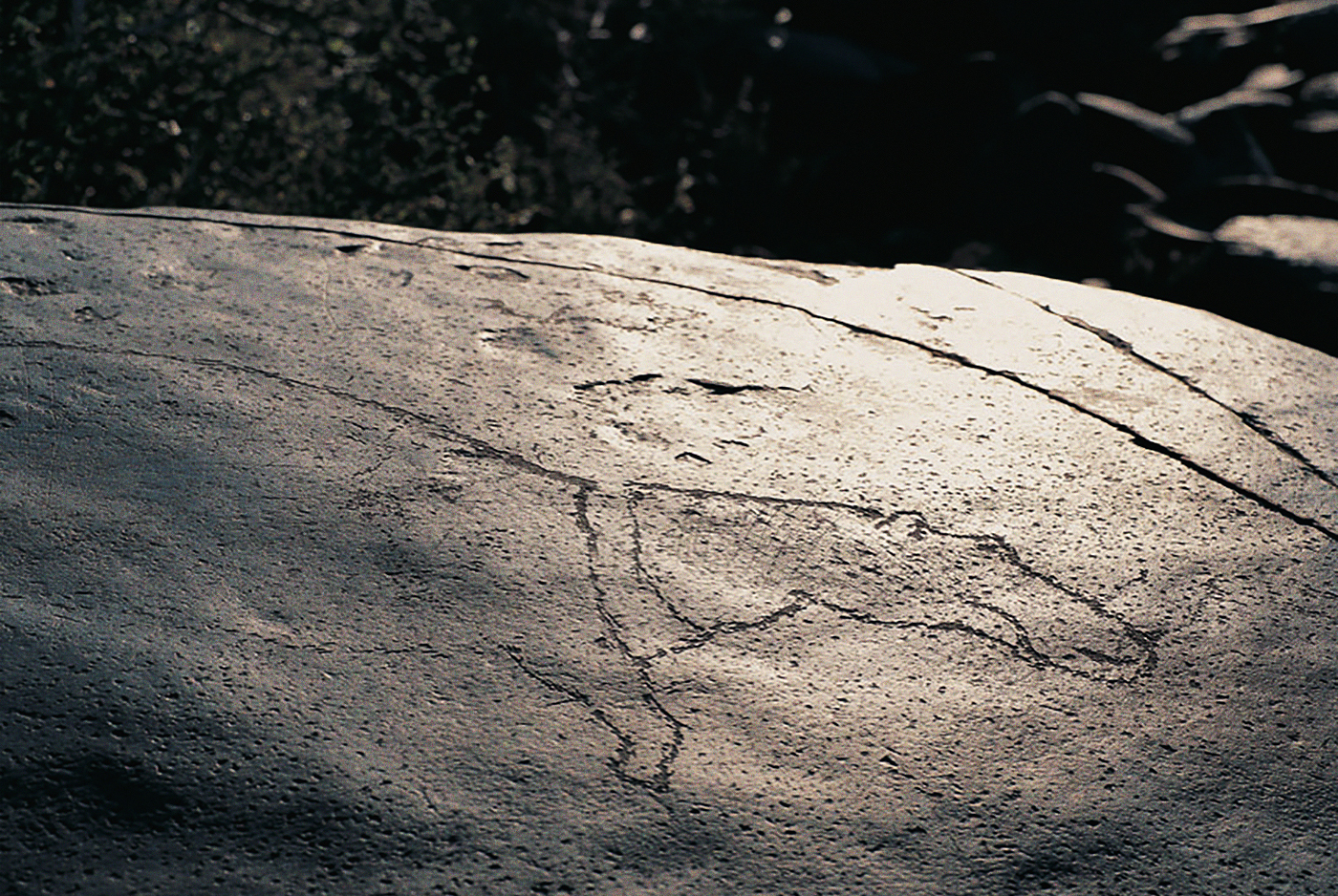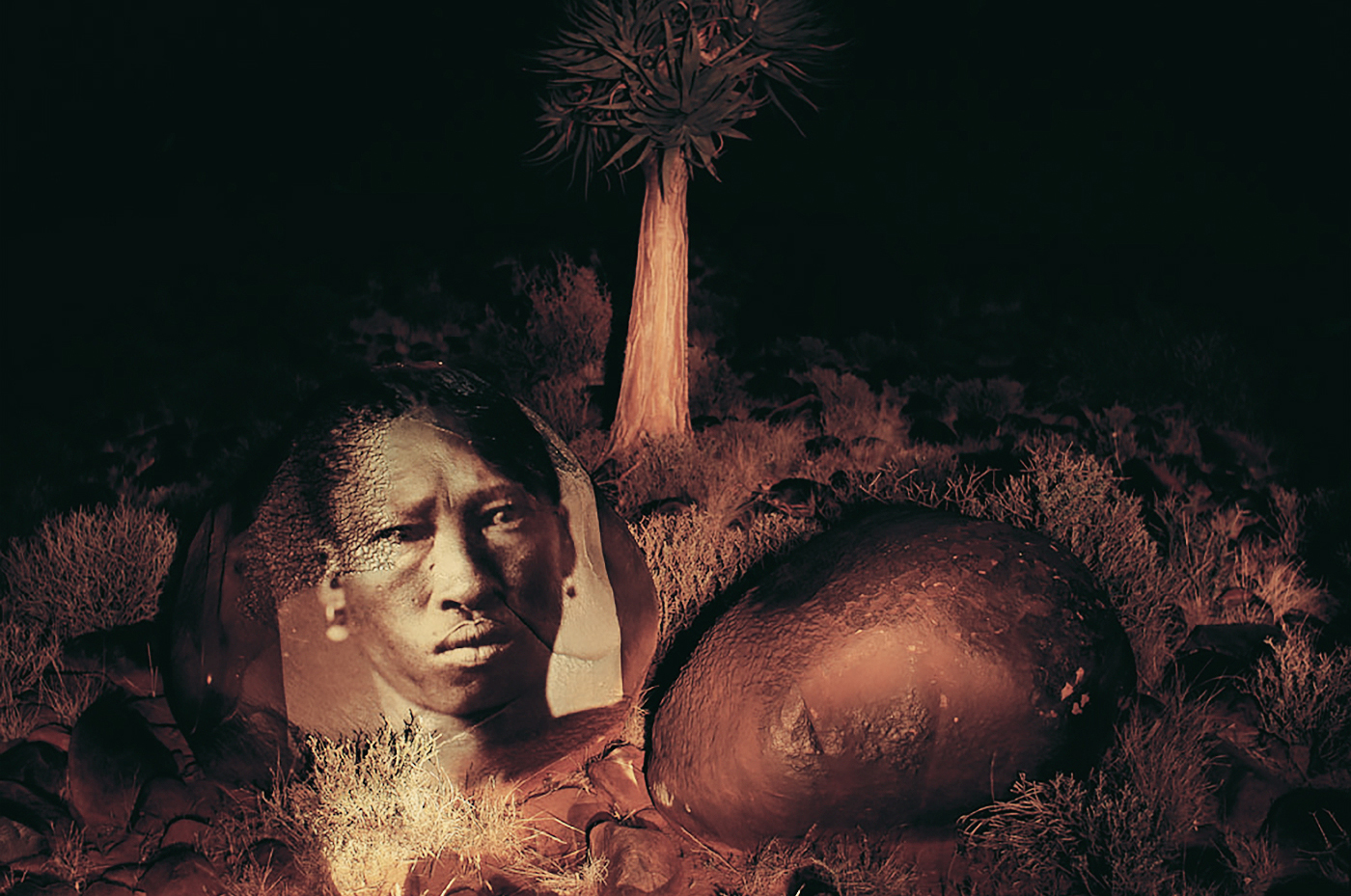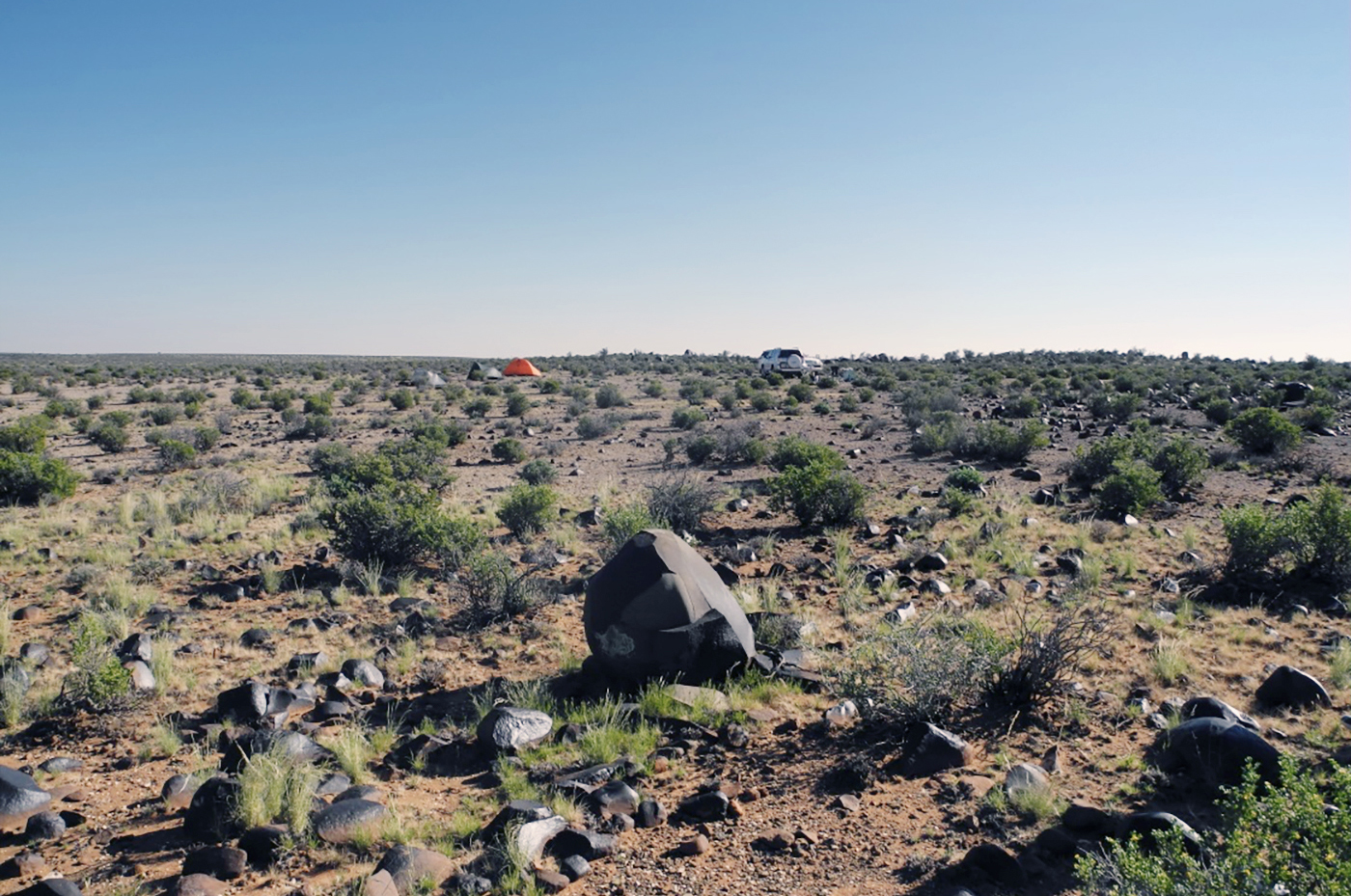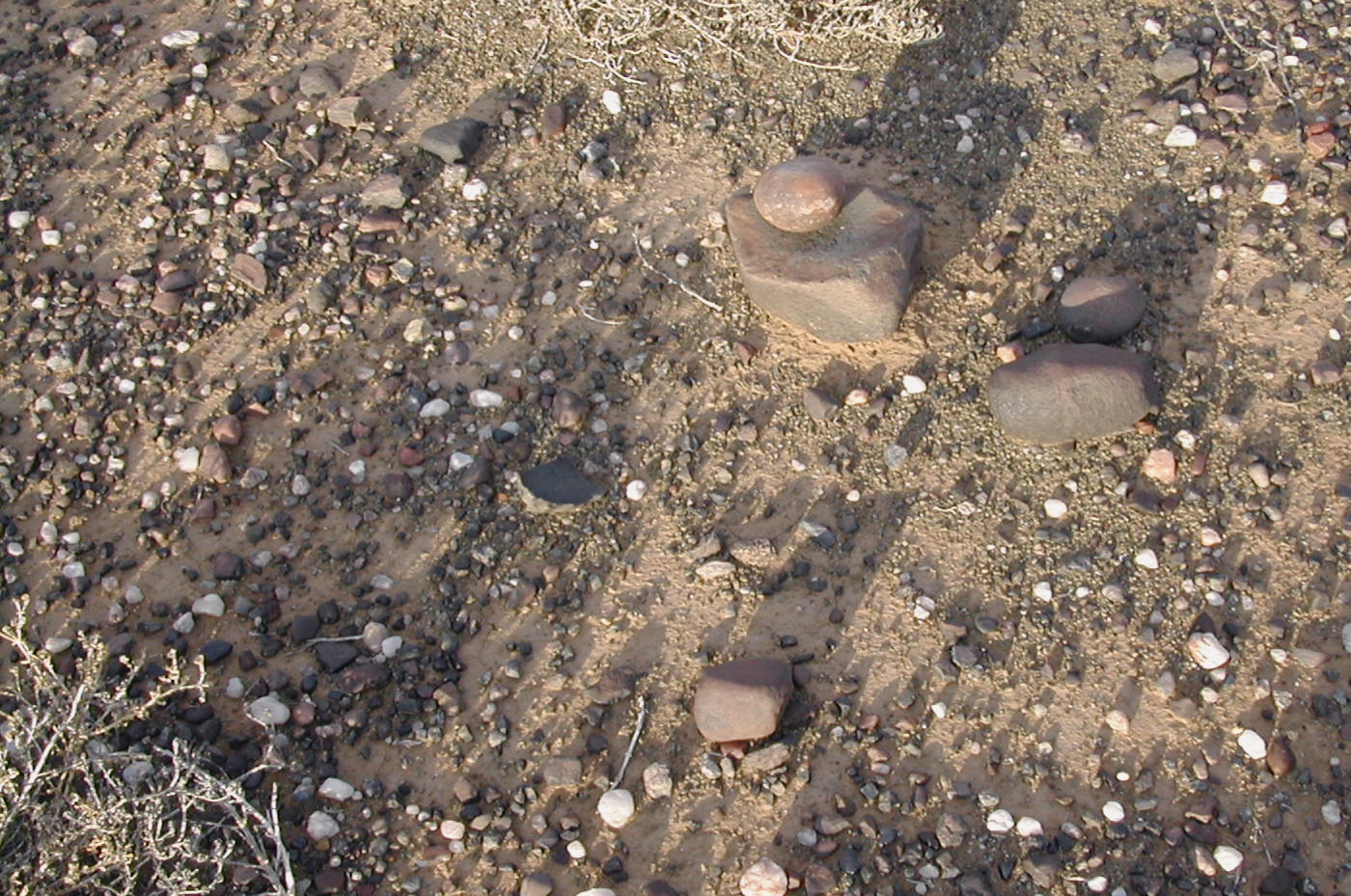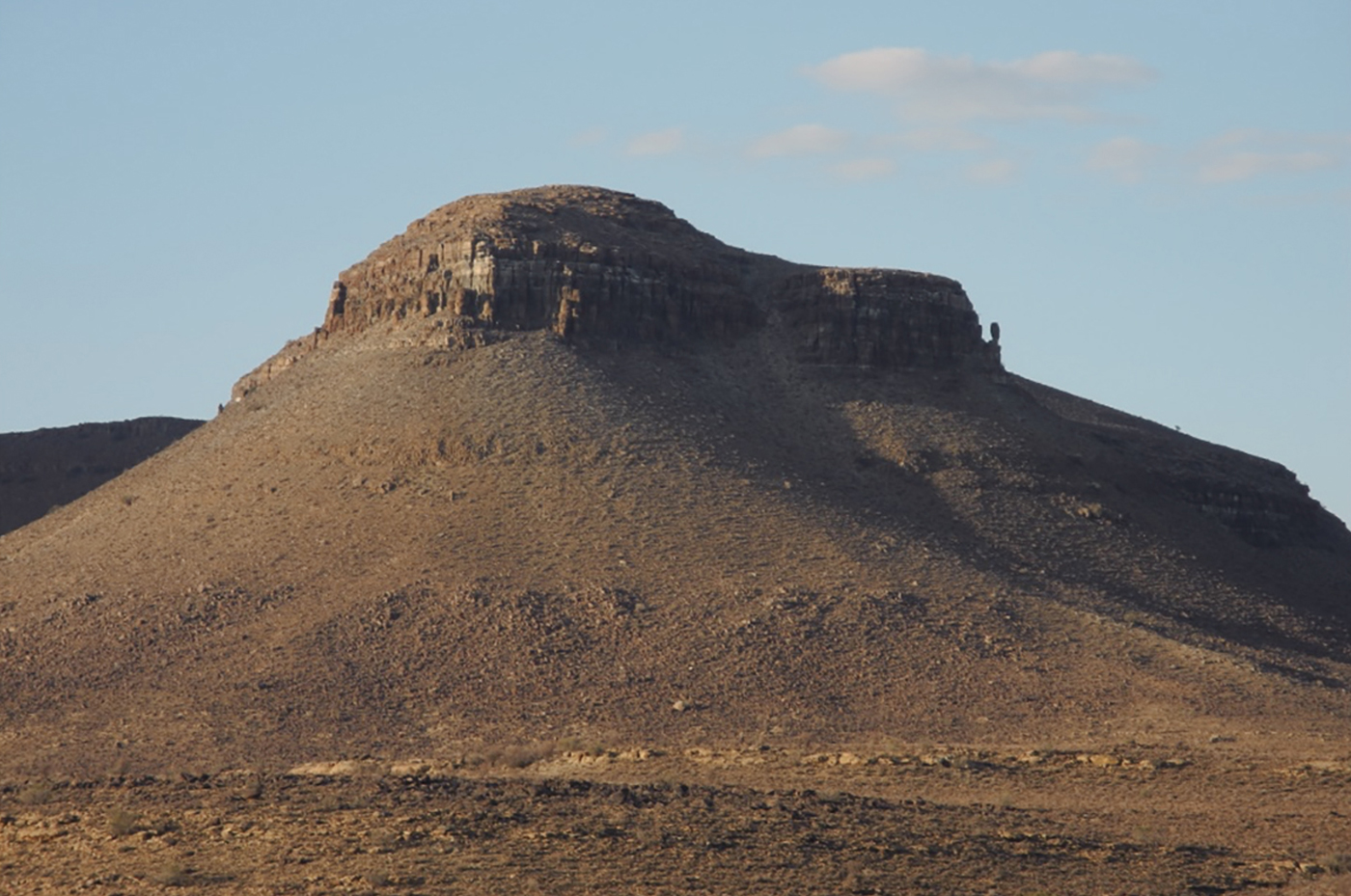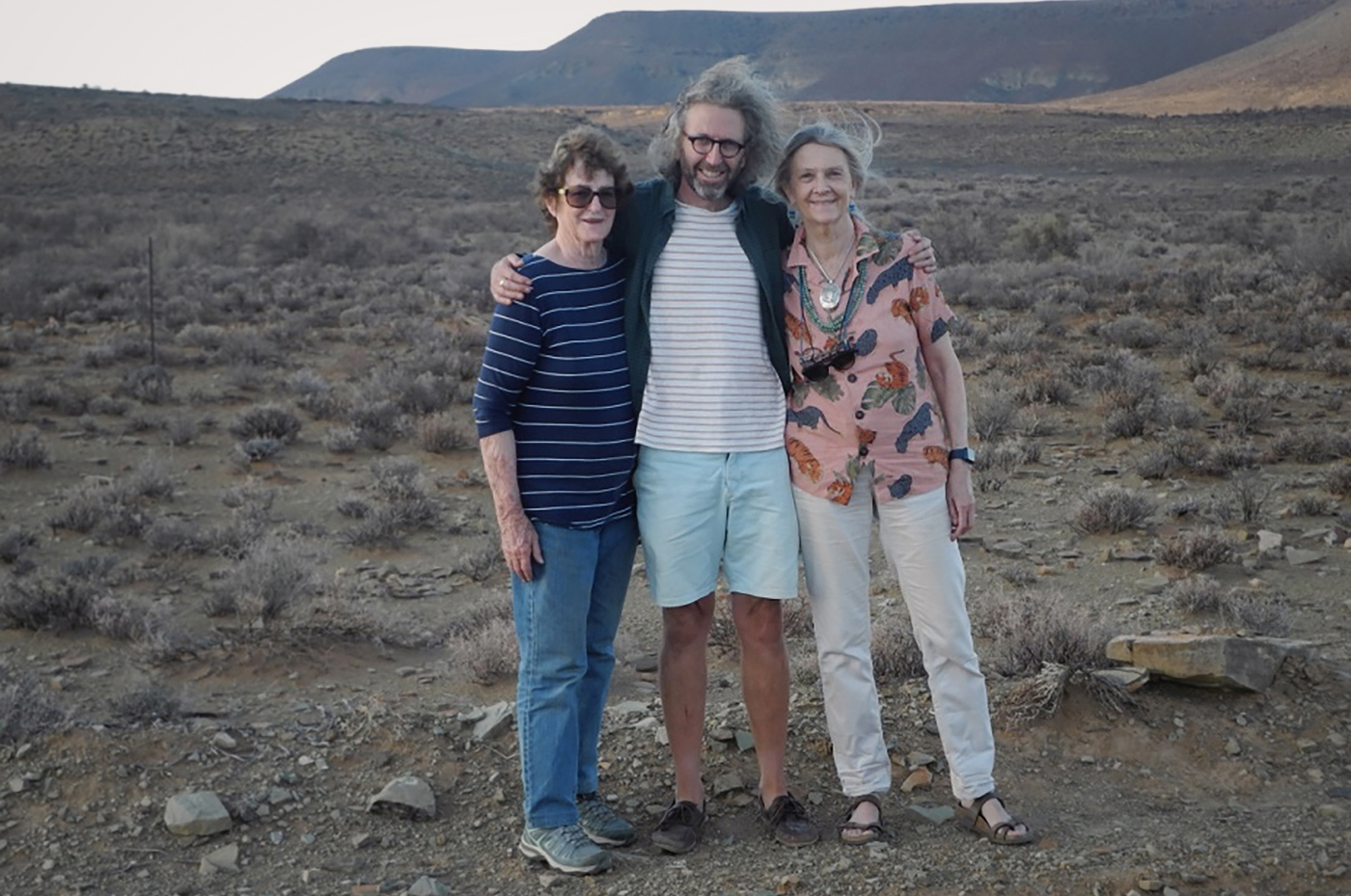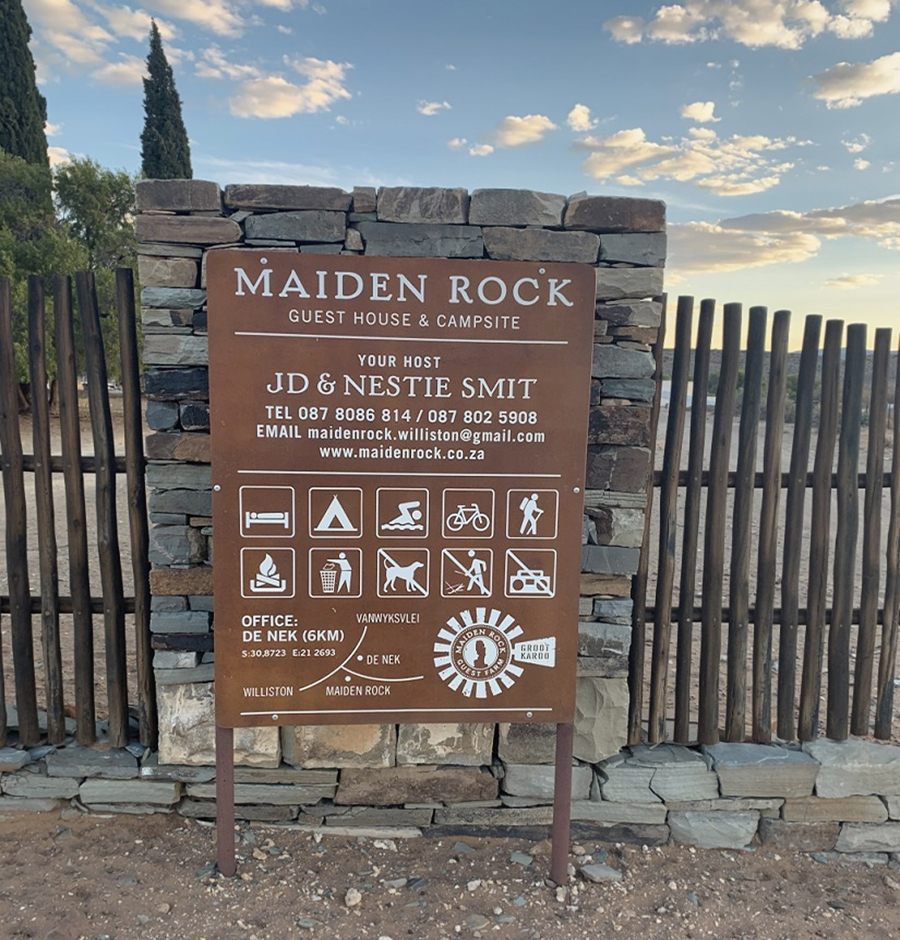
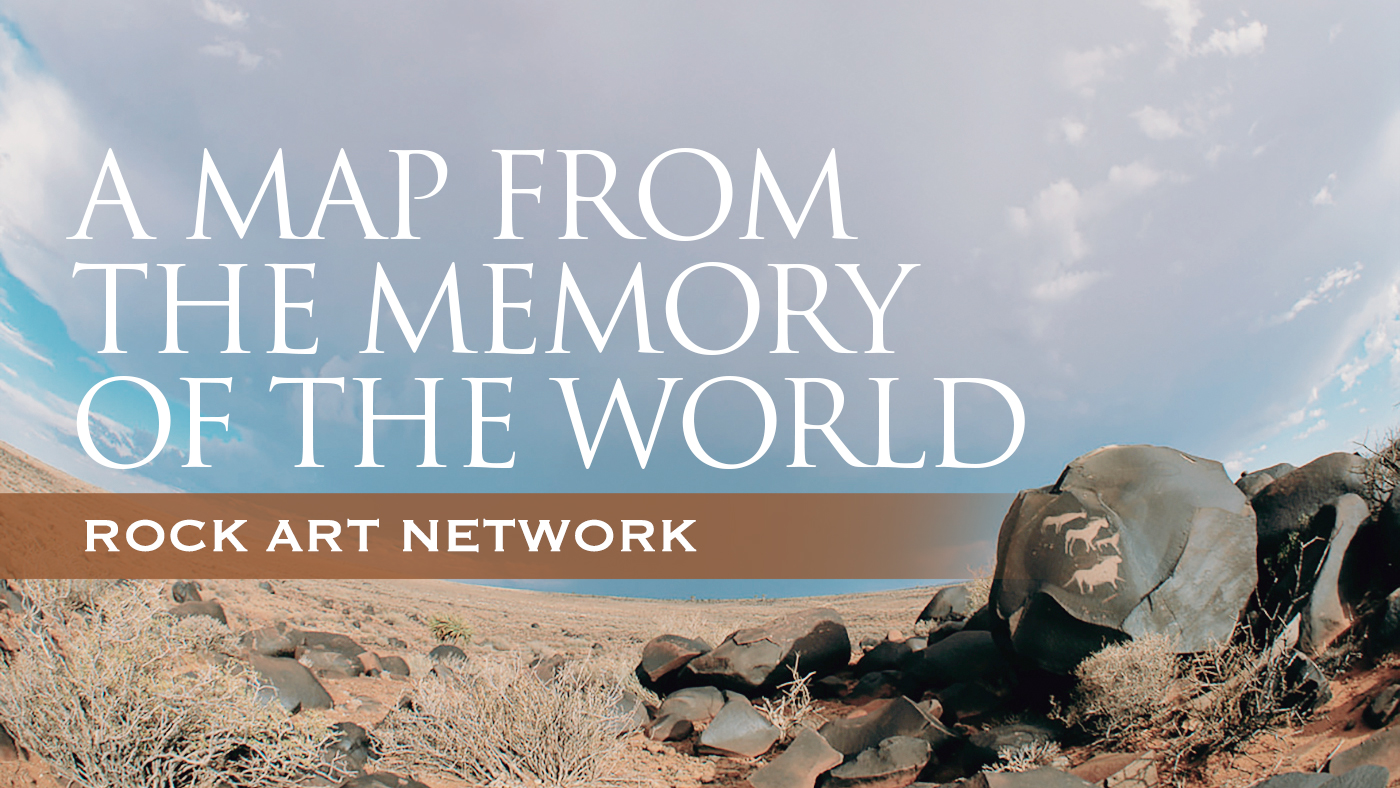
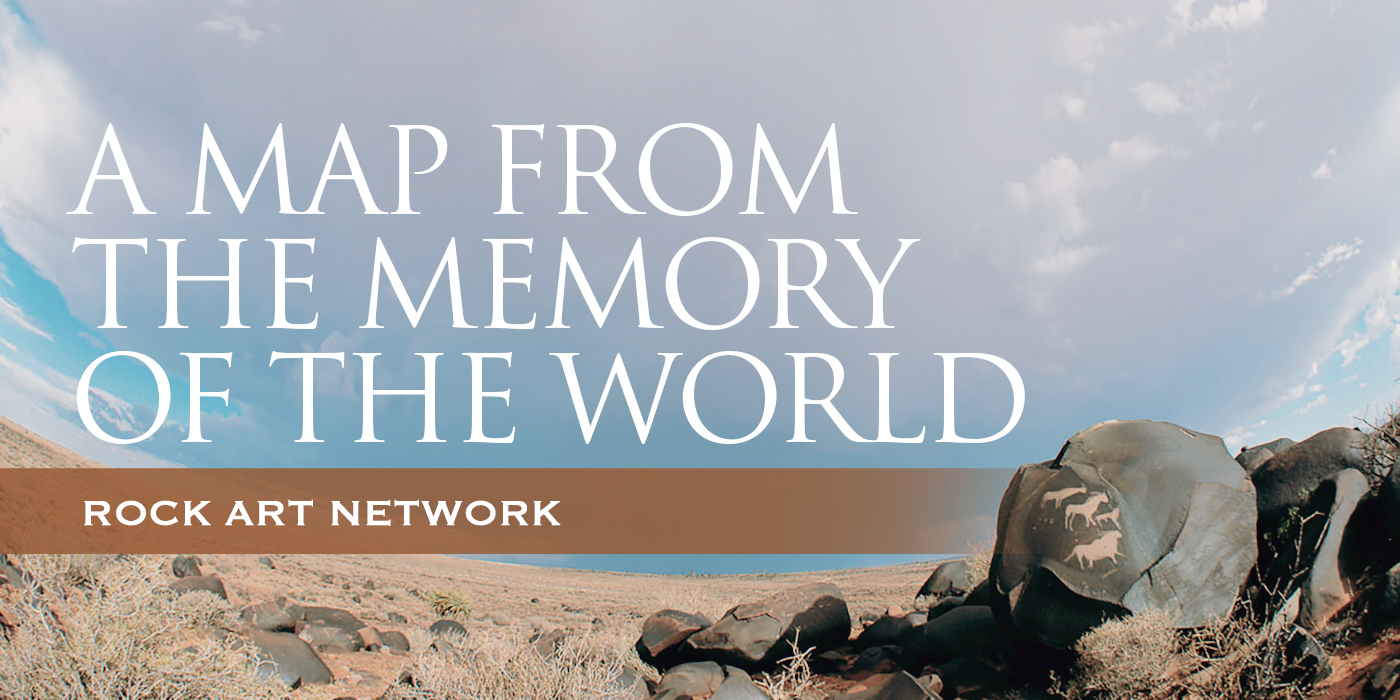
Dolerite boulders on the hill known today as Tafelkop, and the flat country beyond.
by Janette Deacon
Rock Art Network member
It was the thought of this kind of personal memory that was uppermost in our minds in early April 2021 as we stood on a hill in the Northern Cape, South Africa, and looked across the landscape at what was once the country of the |xam Bushmen who lived on these flat lands of the Upper Karoo centuries ago (Fig. 1). In the distance we could see a small tree at the Bitterpits, a water hole that belonged in the mid-nineteenth century to a |xam man named ǁkabbo, or ‘Dream’ (Fig. 2). Around us on the hill were rock engravings (petroglyphs), a rock gong, and stone artefacts that showed the presence of ǁkabbo’s ancestors over thousands of years. In his memory it was a reliable place to find water, and the hill was the place to climb when the springbok herds were likely to appear. Above all, it belonged to him and his family. We were there that day because his memory had been transferred by pen and paper to a map in the hands of Wilhelm Bleek in Cape Town in 1870.
Like the more famous rock paintings, most rock engravings in South Africa were made by the same Later Stone Age San (Bushman) people for much the same reasons and probably over the same time period (mainly within the last 5-10,000 years) as the paintings. The difference is that whereas the painters added colour to surfaces in rock shelters and caves, the engravers removed the darker weathered outer surface of rocks in the open, exposing a lighter monotone surface beneath (Fig. 3). Sometimes they simply outlined the animal in one fine line (Fig. 4). Masters of their craft could make these images visible even in starlight. In the Northern Cape, engravings are found on black dolerite boulders. The images are mostly of animals (Fig. 5, Fig. 6, Fig. 7) through which !gi:ten (ritual specialists in healing and rain-making) drew power from the spirit world for the benefit of the living. An understanding of their significance has been pieced together from the testimony of ǁkabbo and others that was faithfully recorded, and then curated for almost a century, by members of the extended family of Wilhelm Bleek and his sister-in-law Lucy Lloyd.
A rare pool of water after rain at the Bitterpits that ǁkabbo called his place.
Engravings of rain bulls on a hill near Olifantvlei marked on ǁkabbo’s map.
Engraving of an equid, most likely a zebra, on Springbokoog near Olifantvlei.
Appropriately, the Bleek Collection, or more correctly the Bleek and Lloyd Collection, was nominated by the University of Cape Town in 1997 to UNESCO's Memory of the World Project that was established in 1992. It is an international initiative to safeguard the documentary heritage of humanity. It calls for the preservation of valuable archival holdings, library collections, and private individual compendia all over the world that are deemed to be of such significance as to transcend the boundaries of time and culture. The Bleek and Lloyd Collection consists of notebooks, papers and correspondence of Dr W.H.I. Bleek (1827-1875), his sister-in-law Dr Lucy Lloyd (1834-1914), his daughter Dorothea Bleek (1873-1948), and G.W. Stow (1822-1882), a land surveyor and contemporary of Bleek’s. Together the documents record the results of research into the now extinct |xam San language, beliefs and folklore. A large proportion of the collection has been scanned and digitized at the University of Cape Town thanks to the faithful and untiring efforts of Professor Pippa Skotnes since the late 1980s, and is freely available online at http://lloydbleekcollection.cs.uct.ac.za.
The map drawn in 1870 by Wilhelm Bleek with information from ǁkabbo about his home territory. The town of Kenhardt is at the top, left of centre.
Places marked on ǁkabbo’s map (numbered closed circles) or that are mentioned in the |xam texts (open circles) and still retain the same names a century later. Exceptions are the towns of Brandvlei and Carnarvon that had not yet been named as such in 1870. The numbered places are described in detail elsewhere (Deacon 1986).
Since my first exploratory trip in 1985, I have been to the |xam heartland more than 50 times and as the memory of this part of the world has unfolded from the map, boundaries of time and culture have indeed been transcended. It is clear from analysis of the rock engravings that the choice of subjects is indeed similar to that in the Drakensberg paintings with the eland the most common animal, and human figures often displaying the postures of trance. I often had the feeling, though, that the landscape must still be populated by memories of the |xam teachers whose lives had been turned upside down by foreigners with colonial laws and practices, but how could this be expressed in photographs that made them visible? After a chance meeting with photographer and filmmaker Craig Foster in 1998, we experimented with several ideas. I had read a review of a book that described how Jorma Puranen, the author of Imaginary Homecoming (1999), had printed photographs of Sami people taken in the early twentieth century in Finland and had photographed the photographs in the landscape from which these people had come. We tried it in the |xam landscape but the contrast was too stark. Instead, Craig made 35 mm colour slides of the photos taken of |xam people in the 1870s and we projected them onto surfaces in the landscape in the early evening and at night with torchlight to illuminate surrounding areas. The effect was electrifying and we had much satisfaction taking people like ǁkabbo, Dia!kwain and |hanǂkass’o home in our book My Heart Stands in the Hill published in 2005 (Fig. 10, Fig. 11).
ǁKabbo’s face projected onto a quiver tree near Olifantvlei, at the southern end of the Flat Bushman territory marked on his map.
|hanǂkass’o face projected onto rock in his home territory south of the Bitterpits.
Grindstones and stone artefacts mark the place where a |xam family made their camp a few kilometres from the Bitterpits.
Dia!kwain gave directions to this hill near Groot Pardekloof with a freestanding pillar of stone on the right. It was seen as proof of a broken taboo in the story of The Young Man who was Turned to Stone at the Glance of a New Maiden.
Within sight of the young man who was turned to stone, accommodation is offered that advertises his story.
Engraving of an elephant on a dolerite hill near the Bitterpits where ǁkabbo once lived.
Miraculously we had no punctures, and left the Flat Bushman territory before the locusts began to swarm. We will return to re-locate engravings of elephants within sight of the Bitterpits (Fig. 17) and to keep the memories on the map alive and add new ones. Five days after we arrived home, a fire at the University of Cape Town library and special collections building became a nightmarish reminder not only of the need to preserve memories of the world like the Bleek and Lloyd archive, but to appreciate just how precious they are.
For further details, contact janette@conjunction.co.za or pippa.skotnes@gmail.com.
A small selection of useful references
Bank, Andrew. 2006. Bushmen in a Victorian World. The remarkable story of the Bleek-Lloyd Collection of Bushman folklore. Cape Town: Double Storey
Bennun, Neil. The Broken String. The Last Words of an Extinct People. London: Viking.
Blanding, Michael. 2014. The Map Thief. New York: Gotham Books.
Bleek, W.H.I. and L.C. Lloyd. 1911. Specimens of Bushman folklore. London: George Allen.
Deacon, Janette. 1986. “My place is the Bitterpits”: The home territory of Bleek and Lloyd's/XAM San informants. African Studies 45 (2): 135-55.
Deacon, Janette. 1988. The power of a place in understanding southern San rock engravings. World Archaeology 20 (1): 129-40.
Deacon, Janette. 1996. Archaeology of the Flat and Grass Bushmen. In Janette Deacon and Thomas Dowson eds. Voices from the past: /Xam Bushmen and the Bleek and Lloyd collection: 245-70. Johannesburg: Witwatersrand University Press.
Deacon, Janette, and Craig Foster. 2005. My Heart Stands in the Hill. Cape Town: Struik.
Deacon, Janette, and Pippa Skotnes. 2014. The courage of ǁkabbo: celebrating the 100th anniversary of the publication of Specimens of Bushman folklore. Cape Town: UCT Press.
De Prada-Samper, J.M. 2017. ‘I have ||gubbo’: ||kabbo’s maps and place-lists and the |xam concept of !xoe. South African Archaeological Bulletin 72 (206): 116–124.
Lewis-Williams, J.D. 1981. Believing and Seeing. Symbolic meanings in Southern San rock paintings. London: Academic Press.
Lewis-Williams, J.D. 2010. The imagistic web of San myth, art and landscape. Southern African Humanities 22: 1-18.
Puranen, Jorma. 1999. Imaginary Homecoming. Oulu: Pohjoinen.
Skotnes, Pippa. 2007. Claim to the Country. The Archive of Wilhelm Bleek and Lucy Lloyd. Johannesburg: Jacana.
Vinnicombe, P. 1976. People of the Eland: Rock Paintings of the Drakensberg Bushmen as a Reflection of their Life and Thought. Pietermaritzburg: Natal University Press.
→ Members and affiliated institutions of the Rock Art Network
by
George Nash
5/09/2024 Recent Articles
→ Sigubudu: Paintings of people with guns in the northern uKhahlamba-Drakensberg
by Aron Mazel
22/07/2024
by Richard Kuba
13/06/2024
by Meenakshi Dubey-Pathak
8/03/2024
by Rock Art Network
6/02/2024
by Rock Art Network
14/12/2023
by Sam Challis
5/12/2023
by Aron Mazel
30/11/2023
by Sam Challis
21/11/2023
by Sam Challis
15/11/2023
by Sam Challis
10/11/2023
by Rock Art Network
6/11/2023
by Rock Art Network
3/11/2023
by Aron Mazel
2/11/2023
by Meenakshi Dubey-Pathak
26/09/2023
by Paul Taçon
24/08/2023
by Aron Mazel
13/06/2023
by Paul Taçon
5/06/2023
by Paul Taçon
15/03/2023
by George Nash
14/03/2023
by Noel Hidalgo Tan
10/02/2023
by George Nash
01/02/2023
by Meenakshi Dubey-Pathak, Pilar Fatás Monforte
29/11/2022
by Aron Mazel, George Nash
21/09/2022
by Paul S.C. Taçon, Sally K. May, Ursula K. Frederick, Jo McDonald
07/07/2022
by Meenakshi Dubey-Pathak
26/07/2022
by Paul Taçon
20/07/2022
by David Coulson
16 June 2022
by Paul Taçon
25 April 2022
by Noel Hidalgo Tan
20 April 2022
by Meenakshi Dubey-Pathak
14 March 2022
by Carolyn Boyd & Pilar Fatás
02 March 2022
by David Coulson
07 February 2022
by Johannes H. N. Loubser
06 February 2022
by Meenakshi Dubey-Pathak
05 February 2022
by Aron Mazel
28 January 2022
by Aron Mazel
8 September 2021
by David Coulson
17 August 2021
by Ffion Reynolds
21 June 2021

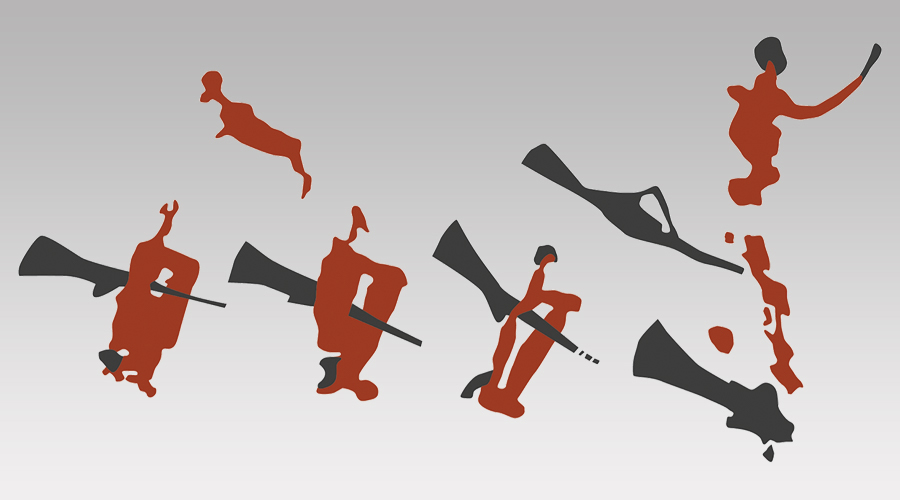
by Aron Mazel
22/07/2024
by Richard Kuba
13/06/2024
by Meenakshi Dubey-Pathak
8/03/2024
by Rock Art Network
6/02/2024
by Rock Art Network
14/12/2023
by Sam Challis
5/12/2023
by Aron Mazel
30/11/2023
by Sam Challis
21/11/2023
by Sam Challis
15/11/2023
by Sam Challis
10/11/2023
by Rock Art Network
6/11/2023
by Rock Art Network
3/11/2023
by Aron Mazel
2/11/2023
by Meenakshi Dubey-Pathak
26/09/2023
by Paul Taçon
24/08/2023
by Aron Mazel
13/06/2023
by Paul Taçon
5/06/2023
by Paul Taçon
15/03/2023
by George Nash
14/03/2023
by Noel Hidalgo Tan
10/02/2023
by George Nash
01/02/2023
by Meenakshi Dubey-Pathak, Pilar Fatás Monforte
29/11/2022
by Aron Mazel, George Nash
21/09/2022
by Paul S.C. Taçon, Sally K. May, Ursula K. Frederick, Jo McDonald
07/07/2022
by Meenakshi Dubey-Pathak
26/07/2022
by Paul Taçon
20/07/2022
by David Coulson
16 June 2022
by Paul Taçon
25 April 2022
by Noel Hidalgo Tan
20 April 2022
by Meenakshi Dubey-Pathak
14 March 2022
by Carolyn Boyd & Pilar Fatás
02 March 2022
by David Coulson
07 February 2022
by Johannes H. N. Loubser
06 February 2022
by Meenakshi Dubey-Pathak
05 February 2022
by Aron Mazel
28 January 2022
by Aron Mazel
8 September 2021
by David Coulson
17 August 2021
by Ffion Reynolds
21 June 2021
Friend of the Foundation


by Aron Mazel
22/07/2024
by Richard Kuba
13/06/2024
by Meenakshi Dubey-Pathak
8/03/2024
by Rock Art Network
6/02/2024
by Rock Art Network
14/12/2023
by Sam Challis
5/12/2023
by Aron Mazel
30/11/2023
by Sam Challis
21/11/2023
by Sam Challis
15/11/2023
by Sam Challis
10/11/2023
by Rock Art Network
6/11/2023
by Rock Art Network
3/11/2023
by Aron Mazel
2/11/2023
by Meenakshi Dubey-Pathak
26/09/2023
by Paul Taçon
24/08/2023
by Aron Mazel
13/06/2023
by Paul Taçon
5/06/2023
by Paul Taçon
15/03/2023
by George Nash
14/03/2023
by Noel Hidalgo Tan
10/02/2023
by George Nash
01/02/2023
by Meenakshi Dubey-Pathak, Pilar Fatás Monforte
29/11/2022
by Aron Mazel, George Nash
21/09/2022
by Paul S.C. Taçon, Sally K. May, Ursula K. Frederick, Jo McDonald
07/07/2022
by Meenakshi Dubey-Pathak
26/07/2022
by Paul Taçon
20/07/2022
by David Coulson
16 June 2022
by Paul Taçon
25 April 2022
by Noel Hidalgo Tan
20 April 2022
by Meenakshi Dubey-Pathak
14 March 2022
by Carolyn Boyd & Pilar Fatás
02 March 2022
by David Coulson
07 February 2022
by Johannes H. N. Loubser
06 February 2022
by Meenakshi Dubey-Pathak
05 February 2022
by Aron Mazel
28 January 2022
by Aron Mazel
8 September 2021
by David Coulson
17 August 2021
by Ffion Reynolds
21 June 2021
Friend of the Foundation





